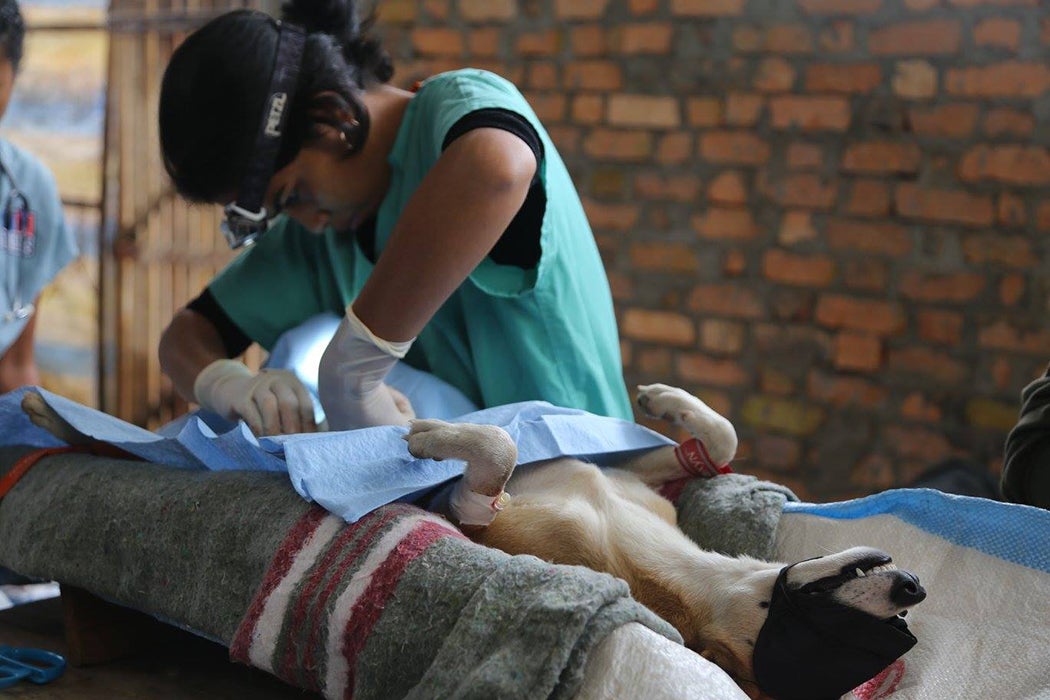Madagascar, an island off the coast of Africa, is a world unto itself. In the jungle village of Andasibe, known for its national wildlife refuge, orb-weaving spiders craft huge webs, jackfruits grow bigger than your head, and lemurs feed on trees at certain times of day. At night, Andasibe’s feral dogs patrol the streets, barking and howling.
These animals are a far cry from our canine friends in the Western world, who live comfortable, secure lives controlled by their owners. In Madagascar, domesticated Canis familiaris (aka dogs) are left to propagate and survive the best they can in an environment much more suited to wild creatures. The dogs–descendants of those brought to the area by the original Austronesian Neolithic settlers 1,500 to 2,000 years ago–breed with their undomesticated counterparts, and compete with other animals for space and food. Exposed to the infections that afflict both humans and wild creatures, the dogs become disease vectors, carrying rabies, distemper, and parvovirus, which they can transmit from animals to humans if they bite. Moreover, the feral dogs have a significant impact on their environment, severely damaging the island’s sensitive ecosystems.
Most wildlife in Madagascar, which has been separated from the mainland for over 80 million years, is unique to the island. About 90 percent of the animals that live here don’t exist anywhere else, from lemurs to chameleons to the surreptitious fossa. The island’s endemic creatures aren’t very adaptable to quick ecological changes. In many parts of Madagascar, feral dogs and these delicate creatures are in conflict. The Andasibe village near the Andasibe-Mantadia National Park, is one such place.

Dogs hunt in forests, affecting how the ecosystems function. Dogs venture into the lemurs’ territory, driving them away and reducing their foraging areas. Dogs also affect how the island’s native predators live. While there had been relatively little research about Madagascar feral dogs’ effect on the island’s endemic carnivores and other animals, some studies noted that the native ring-tailed mongoose has been shifting its hunting and living habits because of the ingress of dogs.
Enter the Mad Dog Initiative
A few years ago a group of scientists and veterinarians founded the Mad Dog Initiative, an organization that uses a holistic approach to control the feral dog problem by spaying and neutering the canines. But the organization does more than simply veterinary work. It provides vaccinations and educational services to the rainforest-adjacent communities. The educational component is vital: Rather than just sticking needles into a bunch of dogs and disappearing, Mad Dog volunteers work with local leaders to explain the problem and the solution, encouraging the villagers to bring their own dogs in for treatment, because pets also hunt and eat wild birds and reptiles, and may contract and spread disease. The impact is twofold: Feral dogs and pet dogs are removed from the reproductive and disease-spreading pools, plus the next generation of dog owners are more willing to bring their pets in for spaying or neutering, because they experience the positive effects firsthand.

Mad Dog volunteers leash up feral canines and lead them to the veterinary encampment. The villagers, who are typically very curious about the procedure, bring in their companion dogs and cats. As their pets undergo the surgery, the owners look on. Pets go back home with their owners the same day. Feral dogs enjoy a longer stay–they get an observation period before being released back onto the streets, during which they get good food and plenty of attention and belly rubs. Once they’re ready to leave, some of the feral dogs just wander off and go on their merry way. Others hang around the clinic seeking a little more love.
To understand how the control of feral dogs impacts wildlife population long-term, Mad Dog deploys camera trap teams, a particularly effective approach for tracing elusive predator species like the fossa. The preliminary results from studies of the dogs’ impact on Madagascar wildlife show that reducing their population helps sustain the endemic species. In fact, attempts to conserve wildlife without controlling the dog population proved ineffective. If we want Madagascar’s lemurs, fossas, and mongooses to survive on the island amid deforestation and ecological perturbations, taming the canine’s spread is a must. Otherwise, many unique Madagascan creatures would quite literally be going to the dogs.







